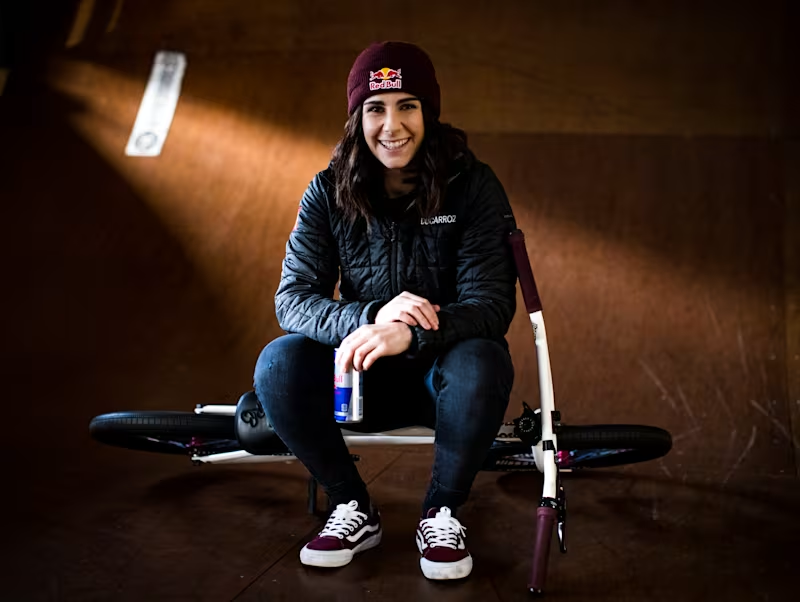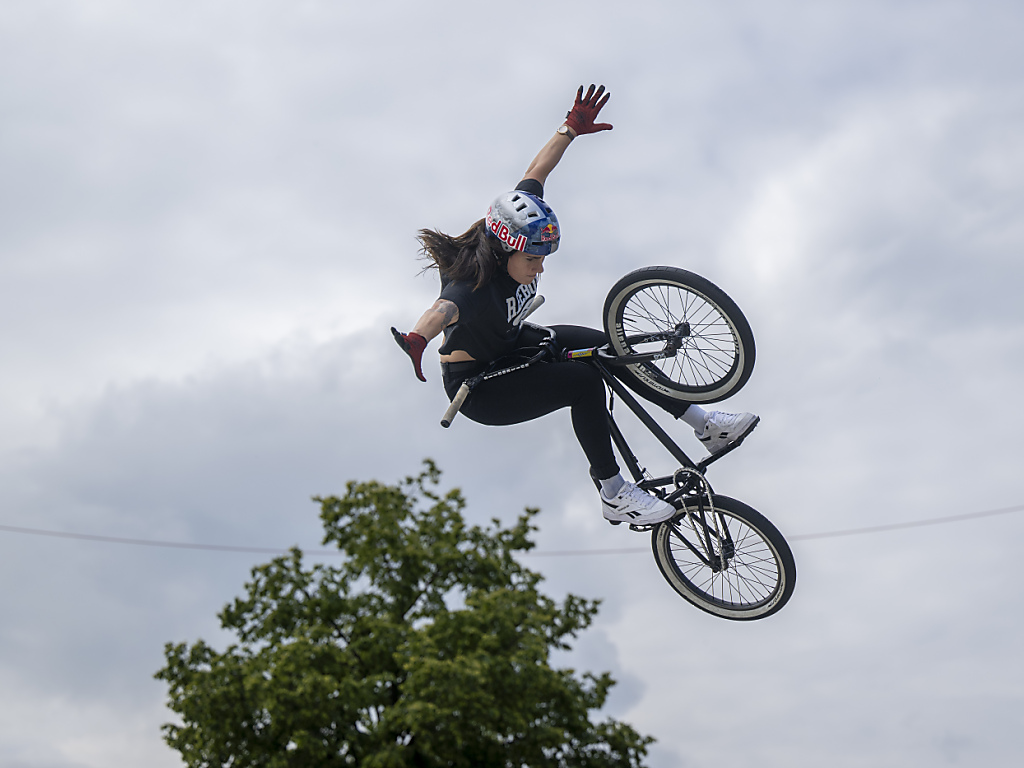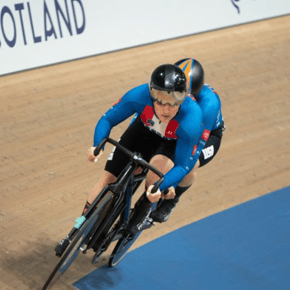 Source: Nikita Ducarroz
Source: Nikita Ducarroz
Most middle school homework assignments aren’t life changing. But then again, some are.
Nikita Ducarroz was just like any other girl in middle school: normal. She had friends, homework, played travel soccer and loved her mom. But suddenly, life started to feel abnormal, like it was spiraling out of her control. Nikita started to have panic attacks so crippling that she couldn’t leave her house. She started doing school at home, and spent her free time uploading rocking covers of early 2010s hits onto her YouTube channel. But somewhere between the Garage Band sound effects and iMovie title screens, something else on YouTube caught her attention: BMX. Nikita had promised her mom that she would bike as a way to get out of the house, and, growing up in Glen Ellen, California, great mountain biking was never far away. But while Nikita loved the rush of downhill speed, what she craved most was the suspension of time and gravity after she hit a jump. What she saw unfolding before her on her laptop looked like a dream: it was cycling, but only the magic bits.
Nikita saw people and bikes moving together in the beautiful dance of flatlands BMX, and the more she saw the more hooked she became.
Nikita saved up for a used BMX bike, strapped on her helmet, and went to the park.
When she started riding, there were 5-10 other girls who rode BMX park, and she knew all of them. On Facebook, that is. There were 5-10 girls that she knew of in the world who rode BMX park. There weren’t women’s divisions in competitions, and, while she was mastering tricks at home, she never had a woman to look up to, a female professional rider she could aspire to emulate. Slowly, the landscape started to change for, and be changed by, Nikita and her contemporaries. More competitions began to include a women’s category, with some even offering equal prize money to the men. Women began earning public recognition, spots on highlight reels and even signed lucrative sponsorship agreements. Brands like Red Bull put women (including Nikita!) on the fast track to the top by including them on their professional rosters.
 Source: Nikita Ducarroz
Source: Nikita Ducarroz
But the highest level of action sports, the X Games, remained closed off to female riders. They were invited to ride demos and showcase their talent, but they had to sit in the stands when it was time to compete. Then, in 2017, the whole landscape of BMX changed: BMX park was going to be included in the 2020 Tokyo Olympics, for both men and women. Inclusion in the Olympics always has a trickle down effect for sports: once the pinnacle exists, there is a rush to build the staircases, escalators and elevators to get athletes there.
It allowed women like Nikita to think for the first time: maybe this isn’t just something I’m going to do for fun. Maybe this is something I’m going to do. Full stop.
Nikita walked away from her first Olympic Games with a bronze medal, suitcases full of new Team Switzerland gear and limitless potential. She was a professional BMX rider: one of the world’s best. She started to gain a dedicated following and have a real platform. She built out a meaningful sponsorship portfolio and continued to train, learn and win. Three years flew by, and then it was time for Paris, 2024. Time to prove that Tokyo hadn’t been an exhibition: that BMX belonged at the Olympic Games to stay, and that all of the trickle down impact had made the women hungrier for success and more talented than before.
.jpeg?width=940&height=560&name=download%20(21).jpeg) Source: Nikita Ducarroz
Source: Nikita Ducarroz
Then the X Games came calling. They were done asking for demos. They wanted the real deal, and extended the long awaited invitation: the invitation to compete. The competition date? One month before the Paris Olympics.
Many male competitors pulled out. The X Games happen every year, and with the risk of injury before the Olympic Games? Not worth it. But for so many female athletes, this was the chance of more than a lifetime. And when push came to shove, Nikita was there on the deck, waiting for her turn to make history.
The thing about making history is we don’t always realize it in the moment. Where once it was unbelievable to see a young girl in a skate park, now they fall and get right back up with the best of them. Where now it’s accepted, and even sometimes applauded, when athletes share about their mental health, that has been an intentional change in culture that has been created by athletes like Nikita.
 Source: Nikita Ducarroz
Source: Nikita Ducarroz
I asked Nikita when she first felt called to openly share her struggles with mental health. Remember the middle school homework assignment?
In 8th Grade, Nikita was asked to record a video for an assignment. She decided to speak about how BMX had helped leave her house, and eventually overcome her anxiety. In addition to submitting the video for school, she uploaded it on YouTube and was floored by the response it received. Through sharing her own struggles, she allowed her friends not only to know her better, but empowered them to be equally vulnerable.
It’s a lesson she’s learned again and again over the years: being vulnerable doesn’t make us weak. On the contrary. It is through accepting our weaknesses that we can challenge our fears. Over the years, Nikita’s career as a cyclist has challenged every one of her fears, from flying on planes to landing huge tricks. It has helped her prove to herself that she is brave and capable, and that her mind doesn’t get to decide her limitations.
The quiet confidence of someone who has flourished with life-altering anxiety exudes from Nikita in waves. When I asked her about bearing the extra burden of creating the path she needed to walk, Nikita merely shrugged. To her it has always been about wanting to ride her bike. If outdated external structures, rules or fears were preventing her from riding her bike, it seemed natural to her to help change those rules, or to work towards conquering those fears. She has overcome so many barriers, both personal and structural, on her way to athletic excellence. And perhaps the most incredible thing is you would never know it talking to her. Nikita is jaw-droppingly talented as well as fiercely determined and extremely accomplished.
But instead of her resume screaming, “Look at me!” everything about Nikita’s work has quietly yet confidently said, “Look at us. Look at what we can accomplish with open minds and open doors.” Her career has constantly been about lifting up other riders, and amplifying athlete voices to create a safe, shared community in which younger athletes can develop.
Chasing her own dreams and battling her own demons has never made her too busy to reach back out, and if you don’t know a lot of elite athletes, you don’t know how rare that is.

Source: Nikita Ducarroz
Nikita’s trailblazing career has taken her all over the world: to the Olympic Games, the X Games, and every backyard game in between. I was curious: for someone who’s accomplished so much, what’s left? The one piece of hardware absent from Nikita’s case is an X Games medal, so she’s still chasing that particular podium. Besides that? She’s focused in on having fun, and is committed to finding the joy that made her fall in love with BMX again and again. Just like any good trick, finding true happiness takes a little bit of practice.
Nikita’s Tips
Nikita’s career has brought her to some of the brightest stages in sports, so we asked her to share some of her hard earned wisdom when it comes to controlling her mind in big moments.
PMR
PMR stands for Progressive Muscle Relaxation, and is a way to relax both the body and mind. Nikita uses PMR if she’s having racing thoughts the night before a competition, or even when she’s waiting on the deck for her turn to compete. The technique basically includes tensing and relaxing muscle groups one at a time, and is often paired with intentional breathing. Nikita found that deep breathing alone didn’t work for her, but PMR gave her something more concrete to hold on to as she worked on focusing and relaxing.
Visualization
Nikita also uses visualization to help quell night before nerves, and also to focus her mind while waiting on the deck. She says she’ll often visualize herself performing a particularly difficult trick, or even take herself through her whole run in her mind. Doing so allows her to slow down and envision herself succeeding where her mind worries she’ll fail. The practice of visualizing has been proven to aid performance, so it’s never too late to picture your picture perfect execution!
Self Talk
If you zoom in and watch very carefully, you might be able to catch Nikita’s lips moving as she speeds down a ramp during a comp. She says that she uses self talk in competition to both quell negative thoughts, and cue herself to remember technical aspects she has been focusing on in practice. Cues like, “You can do this!” or “You know how to do this!” may seem simple, but they go a long way towards calming nerves and improving performance.
Don’t forget to tune in to watch Nikita in June at the Salt Lake X Games, and make sure to follow her adventures on Instagram, both on her personal account @nikita.ducarroz and also @m1ndtricks, where she helps amplify athlete stories related to mental health.
About Parity, a Group 1001 Company
Minority-founded in 2020, Parity's mission is to close the gender income and opportunity gap in professional sports. By developing high-impact collaborations between brands, professional women athletes and their fans, Parity has proudly put more than $3.5 million in the pockets of women athletes, attracting dozens of brands to the movement in the process. The platform offers connections to more than 1000 women athletes from 80+ sports, including well over 200 Olympians and Paralympians. For more information on how to tap into the rapidly rising influence and popularity of women athletes, visit https://paritynow.co or follow us on Instagram, LinkedIn, Facebook, and Threads.



.webp?width=600&name=default%20(2).webp)
.jpg?width=600&name=blog-2-jpg-1%20(1).jpg)
